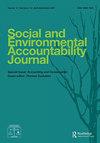生物多样性与灭绝的核算:以南非国家公园为例
Q2 Business, Management and Accounting
Social and Environmental Accountability Journal
Pub Date : 2021-02-25
DOI:10.1080/0969160X.2021.1889385
引用次数: 7
摘要
摘要本文回应了对生物多样性会计和报告进行更规范研究的呼吁。它根据生物多样性报告、生态报告和灭绝核算的早期工作以及国际综合报告理事会和全球报告倡议分别制定的综合和可持续性报告指南,制定了一个生物多样性的报告模式。由此产生的“综合生物多样性报告模式”旨在为生物多样性的报告提供更细致的工具。虽然该模型旨在供多个组织使用,但其应用已使用南非国家公园(SANParks)进行了说明。SANParks七年(2013-2019)年度报告的详细内容分析用于确定不同类型的披露,根据报告的环境信息类型和IIRC概述的相关资本进行分类。将该模型应用于SANParks揭示了如何能够提供比仅使用现有报告框架更详细的生物多样性报告。拟议的报告模式并非没有挑战,但它可以用于更有效地报告与生物多样性相关的风险,以及生物多样性与管理生物多样性所需的不同资源/资本之间的相互联系,本文为关于如何报告生物多样性的争论做出了贡献,并展示了生物多样性报告的主要理论工作如何在实践中应用。本文章由计算机程序翻译,如有差异,请以英文原文为准。
Accounting for Biodiversity and Extinction: The Case of South African National Parks
ABSTRACT This paper responds to calls for more normative research on biodiversity accounting and reporting. It develops a model for reporting on biodiversity informed by earlier work on biodiversity reporting, ecological reporting and extinction accounting as well as the guidance on integrated and sustainability reporting developed by the International Integrated Reporting Council (IIRC) and the Global Reporting Initiative (GRI) respectively. The resulting ‘integrated biodiversity reporting mode’ is designed to provide a more nuanced tool for reporting on biodiversity. While the model is intended to be used by multiple organisations, its application is illustrated using the South African National Parks (SANParks). A detailed content analysis of the SANParks’ annual reports over seven years (2013–2019) is used to identify different types of disclosures, categorised according to the type of environmental information being reported and the associated capitals outlined by the IIRC. Applying the model to SANParks reveals how it is possible to provide a more detailed report on biodiversity than would be the case if only existing reporting frameworks are used. The proposed reporting model is not without challenges, but it can be applied to report more effectively on biodiversity-related risks and the interconnections between biodiversity and the different resources/capitals which are required to manage it. As a result, this paper contributes to the debate on how to report on biodiversity and demonstrates how the largely theoretical work on biodiversity reporting can be applied in practice.
求助全文
通过发布文献求助,成功后即可免费获取论文全文。
去求助
来源期刊

Social and Environmental Accountability Journal
Business, Management and Accounting-Accounting
CiteScore
3.90
自引率
0.00%
发文量
16
期刊介绍:
Social and Environmental Accountability Journal (SEAJ) is the official Journal of The Centre for Social and Environmental Accounting Research. It is a predominantly refereed Journal committed to the creation of a new academic literature in the broad field of social, environmental and sustainable development accounting, accountability, reporting and auditing. The Journal provides a forum for a wide range of different forms of academic and academic-related communications whose aim is to balance honesty and scholarly rigour with directness, clarity, policy-relevance and novelty. SEAJ welcomes all contributions that fulfil the criteria of the journal, including empirical papers, review papers and essays, manuscripts reporting or proposing engagement, commentaries and polemics, and reviews of articles or books. A key feature of SEAJ is that papers are shorter than the word length typically anticipated in academic journals in the social sciences. A clearer breakdown of the proposed word length for each type of paper in SEAJ can be found here.
 求助内容:
求助内容: 应助结果提醒方式:
应助结果提醒方式:


